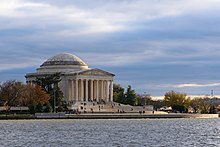Jefferson Memorial | |
 Jefferson Memorial across the Tidal Basin in 2018 | |
Location of Jefferson Memorial in Washington, D.C. | |
| Location | 900 Ohio Drive, S.W., National Mall, Washington, D.C., U.S. |
|---|---|
| Coordinates | 38°52′53″N 77°02′11.5″W / 38.88139°N 77.036528°W |
| Area | 79,758 square feet (7,409.8 m2) |
| Built | 1939–1943 |
| Architect | John Russell Pope; Eggers & Higgins |
| Architectural style | Classical Revival |
| Visitation | 2,312,726 (2005) |
| Website | Thomas Jefferson Memorial |
| NRHP reference No. | 66000029 |
| Significant dates | |
| Added to NRHP | October 15, 1966[1] |
| Designated NMEM | April 13, 1943[2] |


The Jefferson Memorial is a national memorial in Washington, D.C., built in honor of Thomas Jefferson, the principal author of the United States Declaration of Independence, a central intellectual force behind the American Revolution, a founder of the Democratic-Republican Party, and the nation's third president.
Built between 1939 and 1943, the memorial features multiple quotes from Jefferson intended to capture his ideology and philosophy, known as Jeffersonian democracy, which was staunchly supportive of American republicanism, individual rights, religious freedom, states' rights, virtue, and prioritized and valued what he saw as the undervalued independent yeoman. Jefferson was simultaneously deeply skeptical of cities and financiers and hostile to aristocracy, elitism, and corruption. He is widely considered among the most influential political minds of his era and one of the most consequential intellectual forces behind both the American Revolution and the American Enlightenment.
The Jefferson Memorial is built in neoclassical style and is situated in West Potomac Park on the shore of the Potomac River. It was designed by John Russell Pope, a New York City architect, and built by Philadelphia contractor John McShain. Construction on the memorial began in 1939 and was completed in 1943, though the bronze statue of Jefferson was not completed and added until four years after its dedication and opening, in 1947.[3] Pope made references to the Roman Pantheon, whose designer was Apollodorus of Damascus,[4] and to Jefferson's own design for the rotunda at the University of Virginia as inspirations for the memorial's aesthetics.
The Jefferson Memorial and the White House form anchor points to the National Mall in Washington, D.C. The Washington Monument, initially intended to be built at the intersection of the White House and the Jefferson Memorial's site, was ultimately built farther east because the ground at that location was deemed too soft and swampy.[5]
The Jefferson Memorial is a designated national memorial and is managed by the National Park Service of the U.S. Department of the Interior's National Mall and Memorial Parks division. In 1966, the Jefferson Memorial was named to the National Register of Historic Places.[1][6]
In 2007, it ranked fourth on the "list of America's favorite architecture", published by the American Institute of Architects.[7]
- ^ a b "National Register Information System". National Register of Historic Places. National Park Service. January 23, 2007.
- ^ Shalett, Sidney. "President Roosevelt Dedicates a National Memorial to Thomas Jefferson." New York Times. 14 April 1943,1. Retrieved on October 7, 2008
- ^ Documentation of the Jefferson Memorial. Office of the Historic American Buildings Survey/Historic American Engineering Record (HABS/HAER), of the National Park Service. September 1994. Library of Congress. Retrieved October 13, 2008
- ^ The Pantheon: From Antiquity to the Present. Cambridge University Press. ISBN 978-0-521-80932-0.
- ^ Torres, Louis (1984), "To the immortal name and memory of George Washington": The United States Army Corps of Engineers and the Construction of the Washington Monument (PDF), Washington, D.C.: US Government Printing Office, archived from the original (PDF) on June 24, 2016, retrieved April 11, 2018
- ^ Donald C. Pfanz (January 12, 1981). "National Register of Historic Places Inventory-Nomination: Thomas Jefferson Memorial". National Park Service.
- ^ America's Favorite Architecture. American Institute of Architecture. Archived May 8, 2015, at the Wayback Machine. Retrieved October 14, 2008

